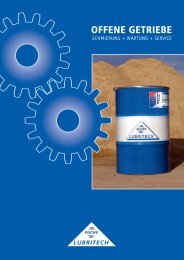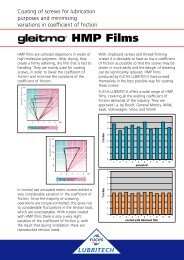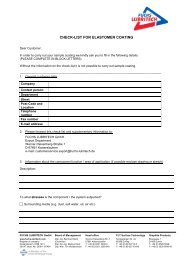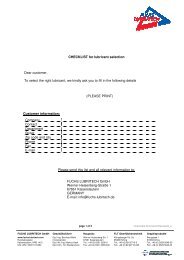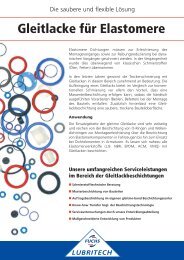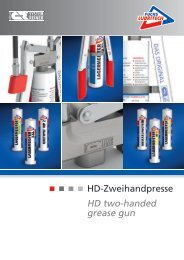english - FUCHS LUBRITECH GmbH
english - FUCHS LUBRITECH GmbH
english - FUCHS LUBRITECH GmbH
Create successful ePaper yourself
Turn your PDF publications into a flip-book with our unique Google optimized e-Paper software.
OPERATIONAL LUBRICATION<br />
OPERATIONAL LUBRICATION<br />
The lifetime of the gear set depends on the selection of the lubricant.<br />
■ ONCE PRIMING and running-in have<br />
been successfully completed, the next<br />
point to be considered is the operational<br />
lubrication. Making the right selection<br />
here is very important for low<br />
wear, for operation without damage,<br />
and for the lifetime of the open gear<br />
drive. The selection of the lubricant depends<br />
on a large number of factors.<br />
These include the stress on the working<br />
tooth flanks, the rotary speed of the<br />
transmission gear, the actual flank temperatures<br />
and the condition of the<br />
drive. Environmental influences such as<br />
dust contamination, humidity, very low<br />
or very high ambient temperatures<br />
must also be considered.<br />
On the safe side with CEPLATTYN<br />
The changeover to operating lubrication<br />
starts at the end of runningin.<br />
When changing to the operating lubricant<br />
a cleaning procedure is not<br />
needed. Just the drum container attached<br />
to the lubrication system has to<br />
be changed. CEPLATTYN lubricants are<br />
adhesive lubricants without heavy metals,<br />
solvents or chlorine. They can support<br />
extremely high pressure, are re-<br />
sistant to water, and are approved by<br />
all leading gear and machine manufacturers.<br />
Changeover to operating<br />
lubrication<br />
In practice the changeover is<br />
achieved through a staged reduction in<br />
quantity towards a target minimum (see<br />
graph on the right). It is necessary to<br />
measure the quantity every time this<br />
value is reduced by the spray system. In<br />
practice, small volumes frequently applied<br />
avoid phases where the drive is<br />
saturated with lubricant which can subsequently<br />
fling. The short pause times<br />
between cycles also avoid insufficient<br />
lubrication. The minimum quantities<br />
consumed by various drives can be<br />
found from the diagram on the right.<br />
Note: The minimum quantity that<br />
can be aimed at depends directly on the<br />
operating conditions. Lubrication rates<br />
below the minimum creates an increased<br />
risk of wear and damage to the<br />
flanks. This can drastically reduce rated<br />
life.<br />
QUANTITY CEPLATTYN KG 10 HMF<br />
Quantity [kg/h]<br />
0.4<br />
0.3<br />
0.2<br />
0.1<br />
Mill Drives min. 0.2-0.4 g/h·mm<br />
Kiln Drives min. 0.1-0.2 g/h·mm<br />
100 200 300 400 500 600 700 800 900<br />
Face width [mm]<br />
10 OPEN GEAR LUBRICATION<br />
<strong>FUCHS</strong> <strong>LUBRITECH</strong> GMBH<br />
specific consumption [g/h·mm]<br />
0.8<br />
0.6<br />
0.4<br />
0.2<br />
0 24 48 72 96<br />
time [h]<br />
Quantity reduction for a single pinion drive.<br />
Central lubricant supply with CEPLATTYN KG 10 HMF.<br />
10<br />
8<br />
6<br />
4<br />
2<br />
Heidelberger Zement AG<br />
Quantity [kg/24h] [kg/24h]



